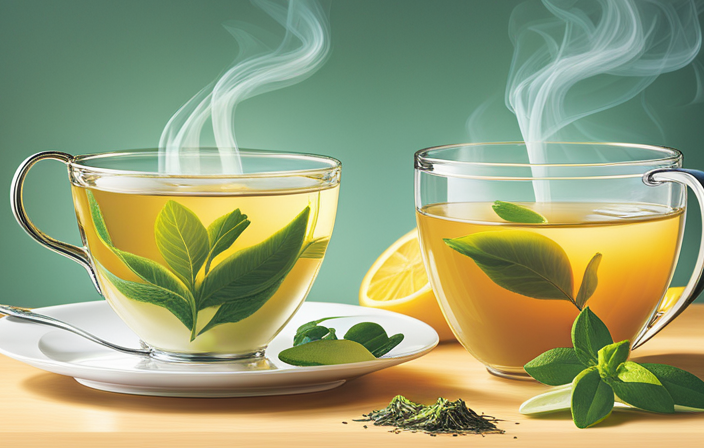I am a huge fan of rooibos tea. Its rich, warm flavor and soothing aroma make it the ideal drink for any time of day.
But have you ever wondered where this delightful drink comes from? Well, prepare to be amazed, because the origins of rooibos are truly fascinating.
Nestled in the Cederberg region of South Africa, this remarkable plant has a long and storied history. It has been cherished by the Khoi and San communities for centuries, who have harvested and consumed it for its numerous health benefits and nutritional value.
Today, rooibos is cultivated using sustainable methods and processed with great care to preserve its distinct taste and qualities. As its popularity continues to grow worldwide, it is important to understand the cultural significance and environmental factors that contribute to the production of this extraordinary tea.
So, join me on a journey to discover the captivating world of rooibos and explore where it truly comes from.
Key Takeaways
- Rooibos tea originates from the Cederberg region of South Africa.
- It has a long history and cultural significance among the Khoi and San communities.
- Rooibos is cultivated using sustainable methods in sandy soil and a Mediterranean climate.
- The fermentation and oxidation process gives rooibos its unique flavor and aroma.
History and Cultural Significance of Rooibos in South Africa
The history and cultural significance of rooibos in South Africa cannot be overstated. Rooibos, also known as ‘red bush,’ has a rich heritage deeply rooted in the Khoi and San communities.
These indigenous groups have a long-standing tradition of harvesting and consuming rooibos, recognizing its many health benefits. Rooibos grows exclusively in the Cedarberg region of South Africa, where it thrives due to the unique environmental factors such as the sandy soil and Mediterranean climate.
The local communities have passed down their knowledge of rooibos cultivation and processing from generation to generation, ensuring its preservation and sustainability. Today, rooibos has become a symbol of South African identity, embraced by people around the world for its distinct flavor and numerous health properties.
Transitioning into the subsequent section, the indigenous harvesting and consumption of rooibos by Khoi and San communities has had a profound impact on the region’s cultural heritage.
Indigenous Harvesting and Consumption of Rooibos by Khoi and San Communities
Explore the rich history of Indigenous Khoi and San communities, who’ve been harvesting and consuming this precious plant for centuries. Rooibos holds a special place in their traditions, with its leaves being used for medicinal purposes and as a soothing tea.
These communities have perfected traditional recipes that incorporate rooibos into their cuisine, adding a unique flavor and health benefits to their dishes. The Khoi and San people have passed down their knowledge of rooibos harvesting and preparation through generations, ensuring the preservation of their cultural heritage.
As we delve into the geographical origin of rooibos in the Cederberg region, it becomes clear that these Indigenous communities have played a vital role in the cultivation and propagation of this remarkable plant.
Geographical Origin of Rooibos in the Cederberg Region
Nestled within the breathtaking landscapes of the Cederberg region lies the very birthplace of the beloved and enchanting rooibos plant. The unique Cederberg landscape provides the perfect conditions for rooibos to thrive.
The plant requires a specific climate and soil type, both of which are found abundantly in this region. Rooibos farming techniques in the Cederberg involve carefully cultivating the plants in well-drained sandy soil and ensuring they receive ample sunlight. Farmers also employ methods such as pruning and weeding to promote healthy growth and maximize yield.
The Cederberg region’s ideal combination of climate, soil, and farming techniques has made it the primary source of high-quality rooibos worldwide. Understanding the geographical origin of rooibos in the Cederberg region is crucial for comprehending the cultivation methods and environmental factors affecting rooibos growth.
Cultivation Methods and Environmental Factors Affecting Rooibos Growth
In the captivating Cederberg region, farmers employ various cultivation techniques and environmental factors that significantly impact the growth of the beloved rooibos plant.
Cultivation methods for rooibos include regular pruning to encourage new growth and the use of organic fertilizers to enhance soil fertility. The plants are typically grown in well-drained sandy soil, which allows for proper root development and prevents waterlogging.
The dry climate of the region, with its hot summers and cold winters, is also crucial for the successful cultivation of rooibos. This unique combination of cultivation techniques and environmental factors creates the ideal conditions for the rooibos plant to thrive and develop its distinct flavor and aroma.
Moving on to the subsequent section about harvesting and processing techniques for rooibos leaves, the careful cultivation methods lay the foundation for producing high-quality rooibos tea.
Harvesting and Processing Techniques for Rooibos Leaves
Harvesting and processing techniques for rooibos leaves are like delicate dances, where skilled hands pluck the vibrant green leaves and gently coax out their rich flavors through meticulous drying and fermentation.
To ensure the highest quality, rooibos leaves are harvested by hand, carefully selecting only the youngest leaves and stems. Once harvested, the leaves are bruised to initiate the fermentation process, where the natural enzymes react and develop the unique flavor profile of rooibos.
After fermentation, the leaves are spread out in thin layers and left to dry in the sun, allowing them to further develop their characteristic reddish-brown color. Finally, the dried leaves are finely cut and packaged to preserve their freshness.
This careful combination of harvesting techniques and processing methods guarantees that every cup of rooibos tea is bursting with its distinctive flavor and aroma.
Now, let’s explore the fermentation and oxidation process that creates rooibos’ unique flavor.
Fermentation and Oxidation Process that Creates Rooibos’ Unique Flavor
To truly savor the distinct flavor of rooibos, you’ll be captivated by the magical transformation that occurs during the fermentation and oxidation process. This process is what gives rooibos its unique taste and aroma.
After the leaves are harvested and cut, they are spread out to dry in the sun. Once dried, the leaves are moistened, which starts the fermentation process. During fermentation, the leaves are carefully turned and monitored to ensure the perfect balance of flavors is achieved. This process can take anywhere from a few hours to a few days, depending on the desired outcome.
After fermentation, the leaves are then oxidized, which further enhances the flavor profile. The result is a rich, earthy taste with a hint of sweetness. It is this combination of fermentation and oxidation that makes rooibos so special.
Moving on to the health benefits and nutritional value of rooibos, it is important to note its numerous positive effects on the body.
Health Benefits and Nutritional Value of Rooibos
You won’t believe the incredible ways rooibos can improve your overall well-being and leave you feeling like a superhero. Rooibos has been the subject of extensive research and health studies, revealing a multitude of health benefits and nutritional value. Here are just a few reasons why you should consider adding rooibos to your daily routine:
- Rich in antioxidants: Rooibos is packed with powerful antioxidants that help fight free radicals and promote a healthy immune system.
- Anti-inflammatory properties: Studies have shown that rooibos can help reduce inflammation in the body, which is beneficial for various health conditions.
- Supports heart health: Rooibos has been linked to lower blood pressure and cholesterol levels, reducing the risk of heart disease.
- Calming effects: Rooibos tea has a soothing effect on the nervous system, promoting relaxation and better sleep.
With its numerous health benefits, it’s no wonder that rooibos has become increasingly popular.
Now, let’s explore the popular uses and variations of rooibos tea.
Popular Uses and Variations of Rooibos Tea
One can explore the world of rooibos tea and discover its many popular uses and delicious variations. This versatile tea can be enjoyed in a variety of ways, from traditional brewing methods to unique recipes that highlight its distinct flavor. Popular recipes include rooibos iced tea, rooibos-infused cocktails, and even rooibos-flavored desserts like ice cream and cakes. To enhance the flavor, some people like to add honey, lemon, or other natural sweeteners to their rooibos tea. When it comes to brewing methods, options include hot brewing, cold brewing, and even using rooibos as a base for herbal blends. With its naturally sweet and nutty taste, rooibos tea is sure to please any palate. Moving on to sustainability and fair trade practices in rooibos production…
Sustainability and Fair Trade Practices in Rooibos Production
When considering the sustainability and fair trade practices of rooibos production, it’s important to understand the impact that ethical sourcing can have on both the environment and the lives of the local communities involved.
For example, imagine a small-scale rooibos farm in South Africa that implements organic farming methods and pays fair wages to its workers, ensuring that the tea is produced in an environmentally friendly and socially responsible manner. Sustainable farming practices not only protect the delicate ecosystem of the region but also promote biodiversity and conserve water resources.
Additionally, fair trade certification ensures that farmers receive fair prices for their crop, enabling them to invest in their communities and improve their quality of life. By supporting sustainable and fair trade rooibos production, consumers can make a positive difference in the world.
Now, let’s explore rooibos in the global market and its growing popularity worldwide.
Rooibos in the Global Market and its Growing Popularity Worldwide
Discover the global market’s increasing fascination with the rich and flavorful rooibos tea, as its popularity continues to soar worldwide.
Rooibos, also known as red bush tea, has witnessed a surge in demand due to its unique taste and numerous health benefits.
In recent years, the rooibos market has experienced significant growth, with consumers recognizing its potential as a healthy and refreshing beverage.
The rising awareness of rooibos health benefits, such as its high antioxidant content and potential to aid digestion and promote relaxation, has contributed to its growing popularity.
Additionally, the versatility of rooibos, which can be enjoyed hot or cold and is often used as a base for various blends, has further boosted its appeal in the global market.
As consumers seek natural and healthy alternatives, rooibos has emerged as a beloved choice, making it an exciting time for the rooibos industry.
Frequently Asked Questions
What is the recommended daily intake of rooibos tea for maximum health benefits?
To maximize the health benefits of rooibos tea, it’s recommended to consume it daily. This delightful brew can work wonders for your well-being, promoting overall health and vitality.
Are there any potential side effects or contraindications associated with consuming rooibos tea?
There are no known side effects or contraindications associated with consuming rooibos tea. It is generally considered safe and can be enjoyed in moderation. While it offers potential health benefits, it is important to follow the recommended dosage.
Can rooibos tea be enjoyed hot and cold, or is it best served in a specific way?
Rooibos tea can be enjoyed both hot and cold, making it versatile. While personal preference plays a role, it is commonly served hot with a slice of lemon or honey. However, it can be served iced with a refreshing twist of mint or lemon.
How does the taste of rooibos tea differ from other types of tea?
The taste of rooibos tea differs from other teas in that it is naturally sweet and nutty, without any bitterness. It can be enjoyed hot or cold and is brewed using similar techniques to other teas.
What is the shelf life of rooibos tea, and how should it be stored to maintain its freshness and flavor?
Rooibos tea’s shelf life is indefinite if stored properly. To maintain its freshness and flavor, store it in an airtight container away from heat, moisture, and light. Avoid exposing it to the atrocities of time, like my ex.
Conclusion
After delving into the rich history and cultural significance of Rooibos in South Africa, exploring its indigenous harvesting and consumption by the Khoi and San communities, and uncovering its geographical origin in the Cederberg region, it is clear that Rooibos is more than just a tea.
Its cultivation methods and processing techniques showcase the dedication and expertise of local farmers. With its numerous health benefits and variations, Rooibos has gained popularity worldwide.
Moreover, the focus on sustainability and fair trade practices ensures that this remarkable tea continues to thrive in the global market.










